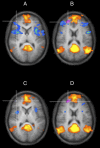Sleep deprivation increases dorsal nexus connectivity to the dorsolateral prefrontal cortex in humans
- PMID: 24218598
- PMCID: PMC3845164
- DOI: 10.1073/pnas.1317010110
Sleep deprivation increases dorsal nexus connectivity to the dorsolateral prefrontal cortex in humans
Abstract
In many patients with major depressive disorder, sleep deprivation, or wake therapy, induces an immediate but often transient antidepressant response. It is known from brain imaging studies that changes in anterior cingulate and dorsolateral prefrontal cortex activity correlate with a relief of depression symptoms. Recently, resting-state functional magnetic resonance imaging revealed that brain network connectivity via the dorsal nexus (DN), a cortical area in the dorsomedial prefrontal cortex, is dramatically increased in depressed patients. To investigate whether an alteration in DN connectivity could provide a biomarker of therapy response and to determine brain mechanisms of action underlying sleep deprivations antidepressant effects, we examined its influence on resting state default mode network and DN connectivity in healthy humans. Our findings show that sleep deprivation reduced functional connectivity between posterior cingulate cortex and bilateral anterior cingulate cortex (Brodmann area 32), and enhanced connectivity between DN and distinct areas in right dorsolateral prefrontal cortex (Brodmann area 10). These findings are consistent with resolution of dysfunctional brain network connectivity changes observed in depression and suggest changes in prefrontal connectivity with the DN as a brain mechanism of antidepressant therapy action.
Conflict of interest statement
The authors declare no conflict of interest.
Figures





Similar articles
-
Ketamine decreases resting state functional network connectivity in healthy subjects: implications for antidepressant drug action.PLoS One. 2012;7(9):e44799. doi: 10.1371/journal.pone.0044799. Epub 2012 Sep 24. PLoS One. 2012. PMID: 23049758 Free PMC article. Clinical Trial.
-
Enhanced amygdala-cingulate connectivity associates with better mood in both healthy and depressive individuals after sleep deprivation.Proc Natl Acad Sci U S A. 2023 Jun 27;120(26):e2214505120. doi: 10.1073/pnas.2214505120. Epub 2023 Jun 20. Proc Natl Acad Sci U S A. 2023. PMID: 37339227 Free PMC article.
-
Prospective Validation That Subgenual Connectivity Predicts Antidepressant Efficacy of Transcranial Magnetic Stimulation Sites.Biol Psychiatry. 2018 Jul 1;84(1):28-37. doi: 10.1016/j.biopsych.2017.10.028. Epub 2017 Nov 10. Biol Psychiatry. 2018. PMID: 29274805 Free PMC article.
-
Resting-state fMRI functional connectivity and mindfulness in clinical and non-clinical contexts: A review and synthesis.Neurosci Biobehav Rev. 2022 Apr;135:104583. doi: 10.1016/j.neubiorev.2022.104583. Epub 2022 Feb 22. Neurosci Biobehav Rev. 2022. PMID: 35202647 Free PMC article. Review.
-
Prediction on treatment improvement in depression with resting state connectivity: A coordinate-based meta-analysis.J Affect Disord. 2020 Nov 1;276:62-68. doi: 10.1016/j.jad.2020.06.072. Epub 2020 Jul 14. J Affect Disord. 2020. PMID: 32697717 Review.
Cited by
-
Sleep deprivation disturbed regional brain activity in healthy subjects: evidence from a functional magnetic resonance-imaging study.Neuropsychiatr Dis Treat. 2016 Apr 12;12:801-7. doi: 10.2147/NDT.S99644. eCollection 2016. Neuropsychiatr Dis Treat. 2016. PMID: 27110113 Free PMC article.
-
Functional Connectivity of White Matter and Its Association with Sleep Quality.Nat Sci Sleep. 2023 Apr 22;15:287-300. doi: 10.2147/NSS.S406120. eCollection 2023. Nat Sci Sleep. 2023. PMID: 37123094 Free PMC article.
-
Evaluation of cellular activity in response to sleep deprivation by a comprehensive analysis of the whole mouse brain.Front Neurosci. 2023 Oct 19;17:1252689. doi: 10.3389/fnins.2023.1252689. eCollection 2023. Front Neurosci. 2023. PMID: 37928729 Free PMC article.
-
Altered Long- and Short-Range Functional Connectivity Density in Healthy Subjects After Sleep Deprivations.Front Neurol. 2018 Jul 16;9:546. doi: 10.3389/fneur.2018.00546. eCollection 2018. Front Neurol. 2018. PMID: 30061857 Free PMC article.
-
Prefrontal networks dynamically related to recovery from major depressive disorder: a longitudinal pharmacological fMRI study.Transl Psychiatry. 2019 Feb 4;9(1):64. doi: 10.1038/s41398-019-0395-8. Transl Psychiatry. 2019. PMID: 30718459 Free PMC article. Clinical Trial.
References
-
- Dallaspezia S, Benedetti F. Chronobiological therapy for mood disorders. Expert Rev Neurother. 2011;11(7):961–970. - PubMed
-
- Pflug B, Tölle R. Disturbance of the 24-hour rhythm in endogenous depression and the treatment of endogenous depression by sleep deprivation. Int Pharmacopsychiatry. 1971;6(3):187–196. - PubMed
-
- Gillin JC, Buchsbaum M, Wu J, Clark C, Bunney W., Jr Sleep deprivation as a model experimental antidepressant treatment: Findings from functional brain imaging. Depress Anxiety. 2001;14(1):37–49. - PubMed
-
- Wu J, et al. Prediction of antidepressant effects of sleep deprivation by metabolic rates in the ventral anterior cingulate and medial prefrontal cortex. Am J Psychiatry. 1999;156(8):1149–1158. - PubMed
-
- Wu JC, et al. Effect of sleep deprivation on brain metabolism of depressed patients. Am J Psychiatry. 1992;149(4):538–543. - PubMed
Publication types
MeSH terms
LinkOut - more resources
Full Text Sources
Other Literature Sources

